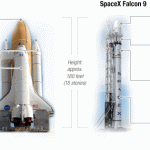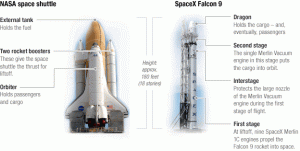http://www.msnbc.msn.com/id/47514404/ns/technology_and_science-space/#.T7whp9z3qf4
We live in exciting times, not as high tech as would have thought in high school in the 1980’s but still very interesting.
Here is a story from MSNBC with regards to the new DragonX Falcoln 9 to launch into space from NASA.
CAPE CANAVERAL, Fla. — A private space capsule called Dragon soared into the predawn sky Tuesday, riding a pillar of flame like its beastly namesake on a history-making trip to the International Space Station.
The unmanned capsule, built by billionaire entrepreneur Elon Musk’s SpaceX venture, is the first non-governmental spacecraft to launch to the space station, ushering in a new era of partnership between the public and private spaceflight programs.
“I think this is an example of American entrepreneurship at its best,” Alan Lindenmoyer, manager of NASA’s commercial crew and cargo program, said in a briefing before the launch. About 100 VIP guests were on hand to witness liftoff, NASA officials said.
Related: Private rocket launch vindicates commercial spaceflight model
Hawthorne, Calif.-based SpaceX, known more formally as Space Exploration Technologies Corp., launched its Dragon capsule at 3:44 a.m. ET Tuesday from a pad here at the Cape Canaveral Air Force Station. It blasted off atop SpaceX’s Falcon 9 rocket, a 157-foot (48-meter) booster powered by nine Merlin rocket engines. The space station was flying 249 miles above the North Atlantic Ocean as the rocket lifted off, NASA officials said. [Launch Photos: SpaceX’s Dragon Blasts Off for Space Station]
The Falcon 9 rocket’s second stage is also reportedly carrying ashes from 308 people, including actor James Doohan, who played Scotty on the 1960s television series “Star Trek,” and Mercury astronaut Gordon Cooper. The ashes were flown under a deal with the memorial spaceflight company Celestis.Reuters
SpaceX Dragon spacecraft
The SpaceX launch vehicle is named after the Millennium Falcon of “Star Wars,” while the capsule got its moniker from the Peter, Paul and Mary song, “Puff, the Magic Dragon.”
Advertise | AdChoicesTuesday marked only the second-ever launch of a Dragon capsule, and the third flight for the Falcon 9 rocket. It was the second attempt to launch the space station-bound test flight, after a launch try on Saturday was thwarted by a faulty rocket engine valve. Repairs were made over the weekend, and the SpaceX team counted down smoothly to Tuesday’s liftoff.
“One thing that they are very good at is being able to work through launch abort and treat those problems and be prepared to go again in a very short time,” Mike Horkachuck, NASA project executive for SpaceX, said Monday.
How the test flight will unfold
Tuesday’s launch could be the last test flight for SpaceX under NASA’s Commercial Orbital Transportation Services program, which is supporting the development of private-sector replacements for the cargo-delivery services of the retired space shuttles. SpaceX has a $1.6 billion contract to fly at least 12 unmanned missions to the space station through 2015.
More space news from msnbc.comAlan Boyle / msnbc.com
The queen of SETI retires from research
Science editor Alan Boyle’s blog: The real-life astronomer who inspired the alien-hunting character in “Contact” is retiring from her research post — but she isn’t giving up on the SETI quest.
Your favorite views of the solar eclipse
Milestone mission to space station lifts off
Space realities keep pace with science fiction
Musk founded SpaceX in 2002 with the goal of boosting commercial access to space and aiming for deep-space exploration, including missions to Mars. Success was never certain or assured, Musk had repeatedly said.
After Tuesday’s launch, Musk said the mission’s uncertainty has eased up.
“Falcon flew perfectly!!” Musk wrote in a Twitter post from Falcon 9’s mission control room in Hawthorne. “Dragon in orbit, comm locked and solar arrays active!! Feels like a giant weight just came off my back.”
The spacecraft is due to spend its first day on orbit catching up with the 240-mile-high (390-kilometer-high) space station, where it will rendezvous Thursday and perform a flyby to within 1.5 miles (2.5 kilometers) to check its navigation systems. [Quiz: How Well Do You Know SpaceX’s Dragon?]
On Friday, the capsule is slated to perform a series of maneuvers to approach the station, with crew members onboard the outpost issuing commands to Dragon. If the spacecraft passes a set of “go/no-go” checks at Mission Control in Houston, NASA will give the go-ahead for the vehicle to approach the space station. From inside, astronauts Don Pettit and Andre Kuipers will use the lab’s robotic arm to grab Dragon and berth it to the station’s Harmony node.
The hatches between the two spacecraft would be opened early Saturday, so the crew can enter Dragon and unpack its deliveries.
Dragon is due to spend about a week and a half attached to the outpost. On May 31, the capsule will be packed with completed science experiments and other equipment, unberthed, and sent back toward Earth. The vehicle is equipped with a heat shield to withstand the fires of re-entry, and is due to splash down and be recovered by ship in the Pacific Ocean.
If this test flight is not completely successful, another demonstration mission would be scheduled later this year.
Giant leap for private spaceflight
Dragon is an unmanned version of a capsule ultimately intended to carry people as well.
Advertise | AdChoicesAnother company, Orbital Sciences Corp. of Dulles, Va., also has a NASA contract to deliver cargo to the space station, and plans to launch its first test flight later this year.
The program is part of a larger effort by NASA to outsource low-Earth orbit transportation to the private sector, allowing the space agency to focus on a new spacecraft and heavy-lift rocket to visit asteroids, the moon and Mars.Robert Pearlman / collectSPACE.com
SpaceX’s first space station-bound Dragon spacecraft, flying atop a Falcon 9 rocket, launches behind a high fidelity mockup of the space shuttle, NASA’s previous means of delivering cargo to International Space Station. Liftoff occurred on May 22 from Cape Canaveral Air Force Station.
The plan has been criticized by some lawmakers and members of the public, who worry that commercial vehicles aren’t as safe or reliable as NASA’s in-house spacecraft.
“It’s really easy to criticize, and it’s very difficult to solve a problem and actually do something,” said SpaceX President Gwynne Shotwell. “So I tend to focus on the business and getting our jobs done and not focus on those that want to criticize.”
NASA officials and leaders of the commercial space sector say the time is right for space to transition from an exclusively government regime to an arena open to private companies.
“I kind of see that transition as being inevitable,” said Phil McAlister, NASA’s director of commercial spaceflight development. “I believe it is going to happen at some point. If it’s not today and this mission falls short of expectations, it is going to happen eventually.”
You can follow Space.com assistant managing editor Clara Moskowitz on Twitter @ClaraMoskowitz.Follow Space.com for the latest in space science and exploration news on Twitter @Spacedotcom and on Facebook.
Here is an exciting video that they allow people to share as well of the launch–>
Visit msnbc.com for breaking news, world news, and news about the economy




